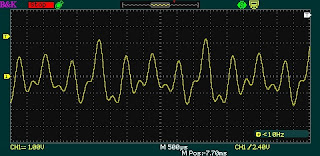why short the leads of a piezo together for shipping ?
I always try to twist the bare leads of a piezo together before mailing a kit, especially if the piezo is put in the same bag as the rest of the kit.
 |
| bare leads twisted together (left side) |
Why ? As seen here a piezo sounder is not only a speaker but can also function as a microphone:
 |
| waveform of me yelling into a piezo |
And as seen here, if a piezo is rapped on a bench top it'll generate a substantial voltage of over 20 volts - don't want that applied to static sensitive parts.
 |
| waveform of piezo brought down hard on bench |
AND, the piezo is a highly capacitive part, seen here measuring 63 nF (or .063 uF)
 |
| the piezo measured at 63 nF |
, we don't want whatever charge is stored on that capacitor to be discharged into the other kit parts.
Is shorting the leads together effective ? I dunno, but most mechanical meter movements are stored/shipped with their terminals shorted together (also some VOMs have an off position that does the shorting), I figure it can't hurt to do the same with a piezo that will be subject to normal shipment handling.
Why did this become a habit ? As I recall I just noticed a click after shorting the leads of an unconnected piezo together, that click had to come from some current flow.
Does this have implications for portable equipment with a piezo in it ? Not sure, the usual dodge is that once in a circuit the MOS devices have all inputs/ground/power connected so any static charge will be able to flow via protection circuitry and not harm the part, who really knows ? :)
Best Regards,
Chuck, WB9KZY
http://wb9kzy.com/ham.htm